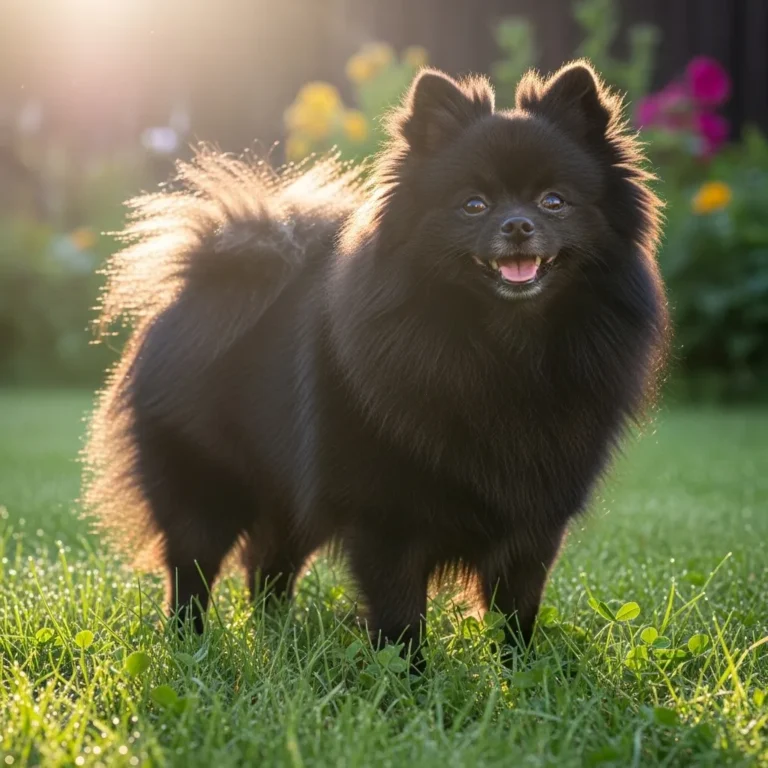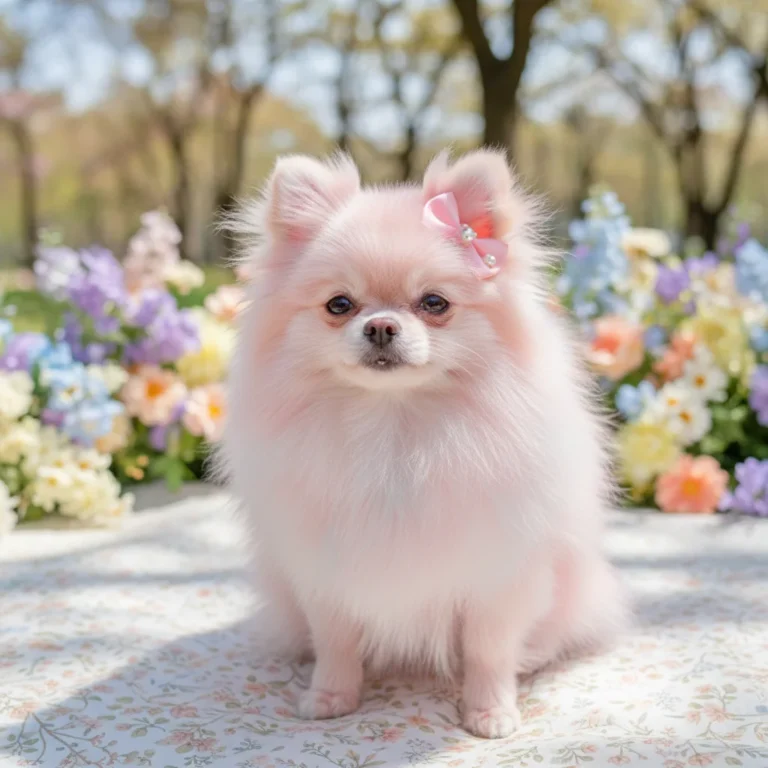
Author: DogsBlogSS Team
⚠️ Disclaimer: This article is for informational purposes only and is not a substitute for consulting a veterinarian.
black pomeranian
If you’ve ever come across a fluffy little dog with a coat as dark as midnight, chances are it was a black pomeranian dog. There’s something undeniably magical about their coal-black fur and feisty, compact personality. These pint-sized spitz dogs carry big energy, plenty of charm, and a loyal heart — but there’s also a lot to know before welcoming one into your home. In this guide, we’ll dive deep into what makes Black Pomeranians special, how to care for them, and what to look for if you’re thinking about bringing one home.
pomeranian black pictures


Understanding Black Pomeranians: General Information
What is a Black Pomeranian?
According to pomeranian: A Black Pomeranian is simply a Pomeranian — but with a rare, all-black coat that makes it look extra elegant. According to breed resources, their coat is a double layer, made up of harsh black guard hairs and a soft, fluffy undercoat.
According to caninejournal: They also typically have black points — meaning their nose, lips, paw pads, and eye rims should all be black in a “true” Black Pom.
According to whatdogbreedami: Physically, they’re a toy breed: small, alert, and with that classic fox-like face and plumed tail.
Are Black Pomeranians rare?
According to caninejournal: You might hear that Black Pomeranians are “rare,” but it’s a bit more nuanced. Early in Pomeranian history, black was actually quite common.
According to caninejournal: Over time, as breeders favored other colors like orange and cream, pure coal-black Poms became less common.
According to pomeranian: they’re “not rare” but can still be hard to find.
Do Black Pomeranians stay black?
According to ukpets: For the most part, yes—true Black Pomeranians tend to keep their dark coat. But there are a few caveats. Some puppies go through what’s often called the “puppy ugly” phase, where their fur may look a bit faded or greyish.
According to pomeranian: Also, too much exposure to sunlight can “bleach” their coat, creating reddish or brownish tinges.
According to caninejournal: And in some cases, markings can emerge — some Poms that look black at first might later show patches of white or tan, making them “mismarked” rather than pure black.
What is the difference between a Black Pomeranian and a regular Pomeranian?
According to happydogbreeds: In terms of behavior, build, and genetics (aside from coat color), Black Pomeranians are the same breed as any other Pomeranian.
According to thegoodypet: The main difference lies in the recessive genetic trait that results in the black coat.
According to allthingsdogs: True Black Pomeranians must be solid black all over — no color markings — and have matching black points.
According to thegoodypet: Their color gene is somewhat less common, which is why breeding true black pups can be tricky.
Are Black Pomeranians purebred?
According to happydogbreeds: Yes — Black Pomeranians can absolutely be purebred. The black coat doesn’t inherently mean a mix. Breed guides confirm that purebred Pomeranians can and do come in black.
According to thegoodypet: That said, because solid black is less common, there’s a higher risk of encountering breeders mislabeling mixed or poorly bred dogs as “black Pomeranians.”
How can you tell if a Pomeranian is truly black?
To confirm a true Black Pomeranian, look for:
- According to pomeranian: A uniform coal-black coat with no stray hairs of another color.
- According to caninejournal: Black pigmentation on nose, lips, paw pads, and eye rims (“points”).
- According to pomeranian: A double coat — that distinct outer guard layer plus a soft undercoat.
- According to pomeranian: Minimal sun damage — check for reddish or brownish fading around the tips, which can suggest sun bleaching.
- Breeder documentation or pedigree if you’re buying — especially if they claim “pure black” and “purebred.”
Care and Characteristics of Black Pomeranians
What are the grooming requirements for a Black Pomeranian?
According to lancasterpuppies: Grooming is one of the bigger responsibilities when you own a Black Pomeranian. Because of their double coat, brushing is essential. According to Lancaster Puppies, you should brush them every other day to help prevent mats and distribute natural oils.
According to ukpets: In heavy shedding seasons (typically spring and fall), you may need to brush more frequently — sometimes daily — particularly to manage loose undercoat.
According to lancasterpuppies: Professional grooming is also common: every 6–8 weeks many owners take their Pomeranians in for trims, paw tidy, and sanitary grooming. Lancaster Puppies Use the right tools — a slicker brush, a metal comb, dog-safe shampoo — and train your Pom to enjoy the routine from early on.
According to caninejournal: Don’t forget: limit exposure to strong sunlight. Over time, UV can bleach the coat and give it reddish or tawny hues.
Do Black Pomeranians shed a lot?
YeAccording to ukpets: s, they do shed — like many double-coated spitz breeds. Their undercoat loosens seasonally, and during those peak times grooming becomes more intensive.
But with consistent brushing and care, shedding can be managed effectively.
What is the temperament of a Black Pomeranian?
According to caninejournal: True to the Pomeranian spirit, Black Pomeranians are intelligent, alert, and spirited.
According to caninejournal: They’re often described as having a big personality in a tiny package. According to Canine Journal, they’re excellent watchdogs — they don’t shy away from barking if they sense something unusual.
According to whatdogbreedami: On top of that: “They quickly learn routines, understand numerous words … their cognitive abilities allow them to master tricks quickly … though their independent streak sometimes leads them to choose when to comply.”
Are Black Pomeranians good family dogs?
According to whatdogbreedami: They can be, absolutely — especially in the right environment. Black Pomeranians bond closely with their families and often attach to one person in particular, but they can be affectionate with everyone. That said, due to their small size and bold nature, early socialization is key.
According to thegoldensclub: Without it, they might become protective, overbark, or suffer from “small dog syndrome,” where they act much larger than they are.
Children should be taught to handle them gently to avoid injury to the dog or kid.
What health issues are common in Black Pomeranians?
Black Pomeranians have many of the same health risks as other Pomeranians, and a few considerations specific to their coat genetics. According to The Goody Pet, common issues include:
- According to thegoodypet: Patellar luxation (knee instability)
- According to thegoodypet: Entropion, where the eyelid rolls inward
- According to lancasterpuppies: Tracheal collapse, due to their small, delicate structure
- According to lancasterpuppies: Syringomyelia, a neurological condition linked to Chiari-like malformation
- According to lancasterpuppies: Alopecia X (sometimes called “Black Skin Disease”), which can cause hair loss or pigment changes — especially a concern in Pomeranian breeding lines.
According to lancasterpuppies: Because of these risks, responsible breeders should screen for these conditions and avoid breeding from lines with known genetic issues.
What is the average lifespan of a Black Pomeranian?
According to whatdogbreedami: Black Pomeranians live quite a long time for dogs, especially when cared for properly. Their typical lifespan is around 12 to 16 years, in line with other Pomeranians.
With regular veterinary care, good nutrition, and love, many Black Poms reach their mid-teens.
How big do Black Pomeranians get?
According to whatdogbreedami: These are true toy-breed dogs. According to multiple sources, they generally stand between 7 to 12 inches tall at the shoulder.
According to allthingsdogs: As for weight, they usually range between 3 to 7 pounds, though some “throwback” or “heirloom” Poms may be larger. Their small size is part of their charm — but it also means their health and care need to be tailored accordingly.
What kind of diet is best for a Black Pomeranian?
Feeding your Black Pom well is essential. While there’s no breed-specific “black coat diet,” general good practices apply:
- High-quality dog food — Choose a premium brand formulated for small or toy breeds, ideally with balanced protein, fats, and carbohydrates.
- Portion control — Because they’re small, they don’t need massive portions. Overfeeding can lead to obesity, which aggravates joint problems like patellar luxation.
- Frequent meals — Some Pom owners prefer feeding twice a day rather than once to maintain stable energy and prevent hypoglycemia, which small dogs can be prone to.
- Supplements — Only under veterinary guidance: some dogs benefit from omega-3s (for coat health) or joint supplements, but you should tailor these to your individual pet.
- Hydration — Always make sure fresh water is available, especially since small breeds can dehydrate quickly.
Acquiring a Black Pomeranian
How much does a Black Pomeranian cost?
According to pomeranian: The cost of a Black Pomeranian puppy can vary significantly, depending on pedigree, breeder reputation, and health checks. According to Pomeranian Headquarters, pet-quality Black Poms typically range between $3,500 to $6,000, and pups from top breeding lines may go up to $7,000 or more.
According to pomeranian:Beyond the purchase price, consider recurring costs too: vet checkups, vaccinations ($85–$250 per visit), worming ($20–$40 per session), grooming, insurance, and other upkeep.
Where can I find a Black Pomeranian puppy?
Here are some good places to look:
- Reputable breeders: Use breed club directories to find trusted Pomeranian breeders.
- According to allthingsdogs: Pomeranian Clubs: The American Pomeranian Club (APC), for instance, can be a starting point.
- Rescue organizations: Occasionally, Pomeranian rescues or general dog adoption agencies may have black Poms.
- Online listings: But be careful — do your homework to avoid puppy mills or scammers. Check for health clearances, pedigree, and breeder reviews.
What should I look for when choosing a Black Pomeranian breeder?
Choosing the right breeder is especially important with Black Pomeranians, since their color genetics can be more complicated. Some key things to watch for:
- According to lancasterpuppies: Health testing: Ask for proof that parents have been screened for patellar luxation, tracheal collapse, syringomyelia, and alopecia X. Good breeders should provide this.
- Pedigree and documentation: Confirm the lineage; make sure black is true black (solid coat, black points).
- According to caninejournal: Breeding ethics: Avoid breeders who advertise “toy” or “teacup” Pomeranians for cheap — these are often unhealthy or misrepresented.
- Living conditions: Visit, if possible. Good breeders will raise puppies in a clean, loving environment.
- Contract: A responsible breeder should have a contract that includes return policies, health guarantees, or spay/neuter agreements.
- References: Ask for references from previous buyers.
Specific Traits & Comparisons
Do Black Pomeranians have black skin?
According to caninejournal: Yes, in many cases, a true Black Pomeranian has black pigmentation on their skin, especially on their nose, lips, paw pads, and eye rims. However, as with any dog, individual variations exist, and not every Pom will have perfectly pigmented skin. Checking breeders’ documentation or even asking for photos of parents can help you verify this trait.
Are Black Pomeranians more expensive than other Pomeranian colors?
According to caninejournal: Often, yes. Because solid black is less common and more challenging to breed for, reputable breeders may charge a premium. That said, cost doesn’t just depend on color — lineage, health screening, and breeder reputation often play a more significant role.
Is it true that Black Pomeranians are calmer?
According to thegoldensclub: There isn’t solid evidence to support the idea that Black Pomeranians are inherently calmer than other Poms. Their temperament aligns closely with the Pomeranian breed in general: intelligent, alert, energetic, and sometimes outspoken. However, an individual dog’s personality can vary widely based on its upbringing, training, and socialization.
Conclusion
Black Pomeranians are magical little dogs. Their striking fur, bold personality, and loyal nature make them dream companions for many. But they’re not just a pretty face — they require thoughtful care, consistent grooming, and knowledgeable breeding to thrive as a healthy, happy family member.
If you’re considering one, take your time. Work with a reputable breeder (or rescue), ask lots of questions, and make sure you’re ready for both the joy and responsibility that come with these ebony clouds of fluff.
Notice : The DogsBlogSS editorial team is dedicated to providing accurate, research-based information about dog health, behavior, and care. All our articles are fact-checked using trusted veterinary sources such as VCA Hospitals, Merck Vet Manual, and the AKC.
you may like it


sources
- https://www.dogster.com/dog-breeds/black-pomeranian (Dogster)
- https://articles.hepper.com/black-pomeranian/ (Hepper Pet Resources)
- https://pomeranian.org/black-pomeranian/ (Pomeranian Headquarters)
- https://whatdogbreedami.com/dog-breeds/pomeranian/black-pomeranian/ (whatdogbreedami.com)
- https://www.ukpets.com/blog/black-pomeranian/ (ukpets.com)
- https://www.caninejournal.com/black-pomeranian/ (Canine Journal)
- https://www.allthingsdogs.com/black-pomeranian/ (All Things Dogs)
- https://happydogbreeds.com/black-pomeranian/ (Happy Dog Breeds)
- https://www.nahf.org/article/pomeranian-dog-black (Nahf)
- https://animalcorner.org/dog-breeds/black-pomeranian/ (Animal Corner)
- https://pomeranians.com.au/black-pomeranian-dogs/ (pomeranians.com.au)
- https://pomeranian.org/wp-content/uploads/2019/12/Common-Health-Issues-Affecting-Pomeranians.pdf (Pomeranian Headquarters)


